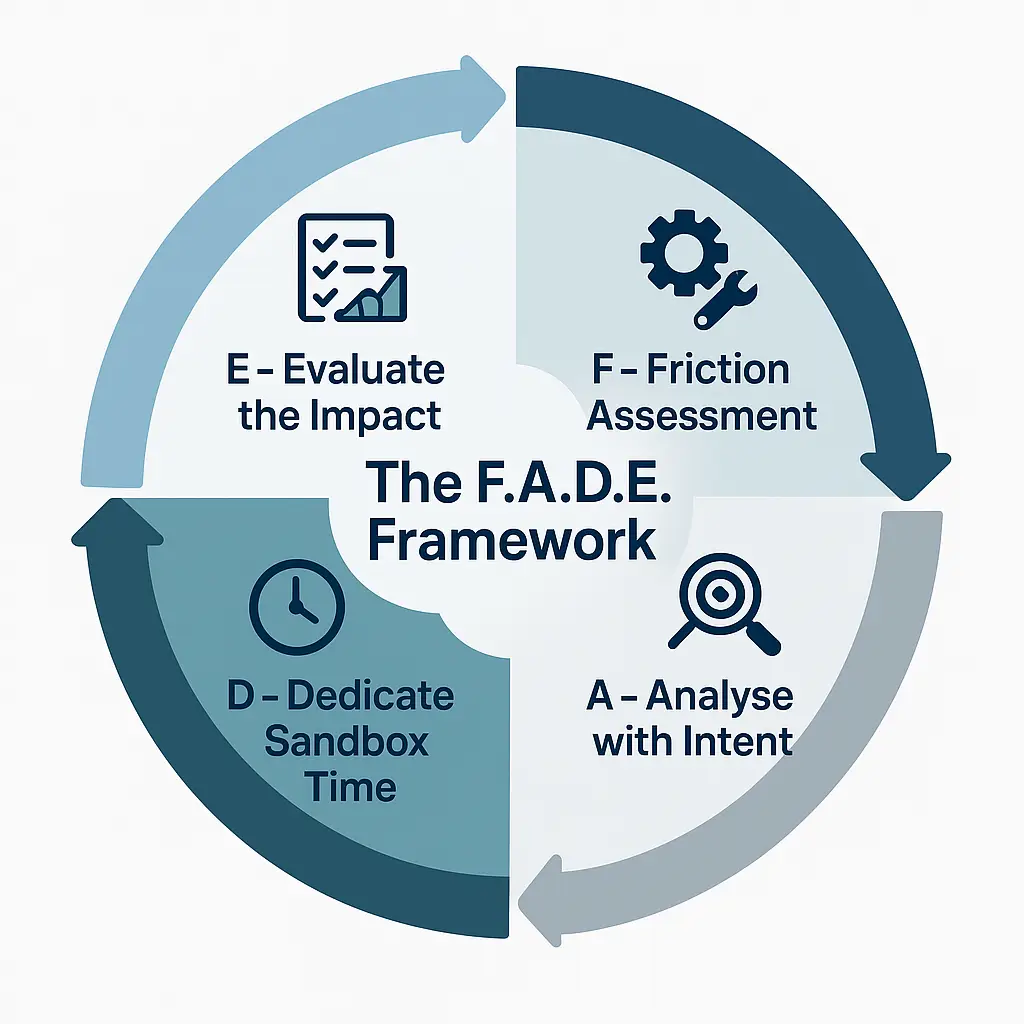AI Overwhelm? Why Critical Thinking is Your “Go-to” Strategy.
Picture this Monday morning scenario: You’re a team leader at a mid-sized Australian company. Your phone buzzes with another “AI breakthrough” notification. Your LinkedIn feed showcases colleagues seemingly mastering complex AI workflows while you’re still figuring out ChatGPT basics. Sound familiar?
If you’re nodding, you’re not alone. Recent data shows that while 49% of Australians are using generative AI, 69% express concerns about AI-powered tools in the workplace. Even more telling: 54% of mid-level managers report feeling overwhelmed at work, with 37% saying this overwhelm makes it hard to perform their jobs effectively.
Here’s the reality: The very technology designed to augment our intelligence is making many Australian professionals feel inadequate and perpetually behind. But there’s a strategic path forward that transforms this firehose of information into focused, practical action.
Before the Strategy: Conquering the Psychological Hurdles of AI Adoption
The Wall is that moment when your carefully crafted prompt returns gibberish. It’s watching a “simple” tutorial that feels impossibly complex when you try it yourself. It’s the creeping doubt: “Maybe I’m just not cut out for this AI revolution.”
This psychological barrier is why 42% of Australian SMEs aren’t planning to adopt AI, despite clear competitive advantages. Overcoming it requires three fundamental mindset shifts:
1. Shift from a "Pass/Fail Test" to "Deliberate Practice"
Learning AI is similar to the process of learning a new musical instrument. Some days you will create something beautiful; other days will be a noise of mistakes. The goal is definitely not immediate perfection; it is consistent, deliberate practice. The value is found in the process of experimentation itself, where every “failed” prompt teaches you what doesn’t work, bringing you closer to what does. I don’t have to search for data on this but I can easily say that for every prompt input, chat models do not return the exact outcome that one would expect. But it will be a good starting point for your AI learning.
2. Find Your Deeper "Why": From Survival to Leverage
- The motivation to push through frustration must be beyond “keeping your job”, instead something more personal and empowering.
- The Joy of Leverage: There is a deep, intrinsic satisfaction in solving a puzzle. Automating a mundane task, you’ve done a thousand times is a powerful intellectual victory. It’s you, using your mind to outsmart the “boring tasks”.
- Reclaiming Your Cognitive Bandwidth: Every hour you save on tedious work is an hour you can reinvest in what truly adds value: creative problem-solving, strategic planning, mentoring a colleague, or building client relationships. I’ve discussed this in my previous blog Beyond the Hype: How AI is Delivering Real Value and Reshaping Work
3. Embrace the "Intelligent Novice" Mindset
As AI researcher Ethan Mollick highlights, generative AI allows us to operate as “intelligent novices” in fields outside our own. You don’t need to be a Python expert to get AI to write a data analysis script. You don’t need a design degree to generate a compelling visual for a presentation. This is an incredible superpower. Approach it with the curiosity of a novice, not the pressure of an expert. Give yourself permission to ask basic questions and be amazed by what you can now accomplish.
The F.A.D.E. Method
With the right mindset established, you need a systematic approach to cut through the noise. The F.A.D.E. Method is designed specifically for time-pressed managers who need results, not another learning project.
In the next few sections we will understand how to use this framework.

F- Friction Assessment
The most common mistake is starting with the AI tool. The correct approach is to start with your own workflow. Conduct a weekly “Friction Audit.”
Actionable Steps:
- At the end of your work week, take 15 minutes to reflect.
- Write down the answers to these questions:
- What single task was the most time-consuming for the least amount of perceived value?
- What part of my job is painfully repetitive or boring?
- Where did I feel like a bottleneck in a team process?
This audit doesn’t give you a vague goal like “learn AI.” It gives you a specific, high-value mission, such as, “Find a way to automate the first draft of my weekly project status report,” or “Develop a system to summarize long research papers in under five minutes.”
A - Analyse with Intent
With a clearly defined problem, you can now search with purpose. This is the critical shift from “just-in-case” learning (hoarding knowledge you might need one day) to “just-in-time” learning (acquiring a skill to solve an immediate need).
Actionable Example:
- Before (Overwhelmed): You see a new feed on AI model/automation and spend an hour watching tutorials “just in case” you need it.
- After (Intentional): Your Friction Audit reveals you hate editing meeting transcripts. Your search becomes laser-focused: “Best AI tools to summarize and find action items in Zoom transcripts.” You are no longer a passive browser; you are an active problem-solver.
D - Dedicate Sandbox Time
Experimentation cannot be an afterthought; it must be a scheduled, non-negotiable part of your week.
Actionable Steps:
- Block out two 30-minute “AI Sandbox” sessions in your calendar. Treat them with the same importance as a client meeting.
- During this time, you are only allowed to do one thing: apply a potential AI solution to one specific problem from your Friction Audit.
- Apply the 80/20 Rule: Your goal is not mastery. Can you get 80% of the desired result with just 20% of the effort? A “good enough” AI-generated first draft that you can then refine in 10 minutes is a monumental win compared to starting from a blank page.
E - Evaluate the Impact
Not every tool will be a winner. To avoid “tool clutter,” you must be a ruthless critic of your own experiments.
Actionable Steps:
After trying a new tool or process, ask these critical questions:
- Net Time Saved: Did this genuinely save me time, or did the setup, prompting, and editing take longer than the original task?
- Quality Improvement: Did the output elevate the quality of my work, or was it generic and uninspired?
- Replicability: Is this process easy enough to become a regular habit?
For every successful experiment, create a simple, one-page “playbook.” Document the tool, the specific prompt you used, and the 3-5 steps to get the result. This playbook becomes your personal, high-value library of proven AI-powered solutions.
Your Most Important Skill: Critical Thinking in the Age of AI
As you integrate these tools into your management practice, remember that your human judgement remains your greatest asset. You’re not becoming an AI technician—you’re becoming an AI-enhanced leader.
- Verify, Don’t Trust: Treat every piece of AI output as a first draft from a brilliant but occasionally flawed intern. It can hallucinate facts, misinterpret nuances, and lack context. Your job is to fact-check, refine, and infuse the output with your own expertise.
- Protect Your Data: This cannot be overstated. Be acutely aware of what you are pasting into public AI models. Avoid sharing sensitive personal data, confidential client information, or proprietary company strategy. Always review the privacy policy of any new tool you adopt.
- Mind the Bias: AI models are trained on the internet, a reflection of humanity’s collective knowledge and biases. Actively question the output. Does it present a balanced view? Does it rely on stereotypes? Your role is to be the ethical filter and ensure the final product is fair, responsible, and aligned with your values.
Conclusion: From Overwhelmed to AI-Enabled
The concluding goal of this journey is not to become an “AI expert.” It is to become an AI-enabled professional. Your enduring value is in your deep domain expertise, your strategic insight, leadership skills and your irreplaceable human judgment—all of which are now backed by the most powerful cognitive tools ever created, AI.
The feeling of being overwhelmed is a signal. It’s a call to stop consuming and start applying to add value to your work productivity. By conquering the psychological hurdles of AI learnings and applying a deliberate framework like the F.A.D.E. Method, you can transform the AI firehose from a source of anxiety into a wellspring of innovation, creativity, and profound productivity.
You are in the driver’s seat. It’s time to lead…
Take action this week:
- Complete your first Friction Assessment this Friday
- Identify one 30-minute sandbox session for next week
- Choose one specific management challenge to address with AI tools
You’re not just keeping up with the AI revolution—you’re leading it in your organisation.
References & Further Reading:
- On Practical AI Application: Ethan Mollick’s “One Useful Thing” newsletter is an essential resource for real-world, no-hype AI experimentation.
- On AI and Productivity: McKinsey & Company’s report, “The economic potential of generative AI,” provides a data-backed view on how these tools are reshaping industries.
- On Managing Information Overload: The Harvard Business Review article, “Death by Information Overload,” offers timeless strategies that are more relevant than ever in the age of AI.
